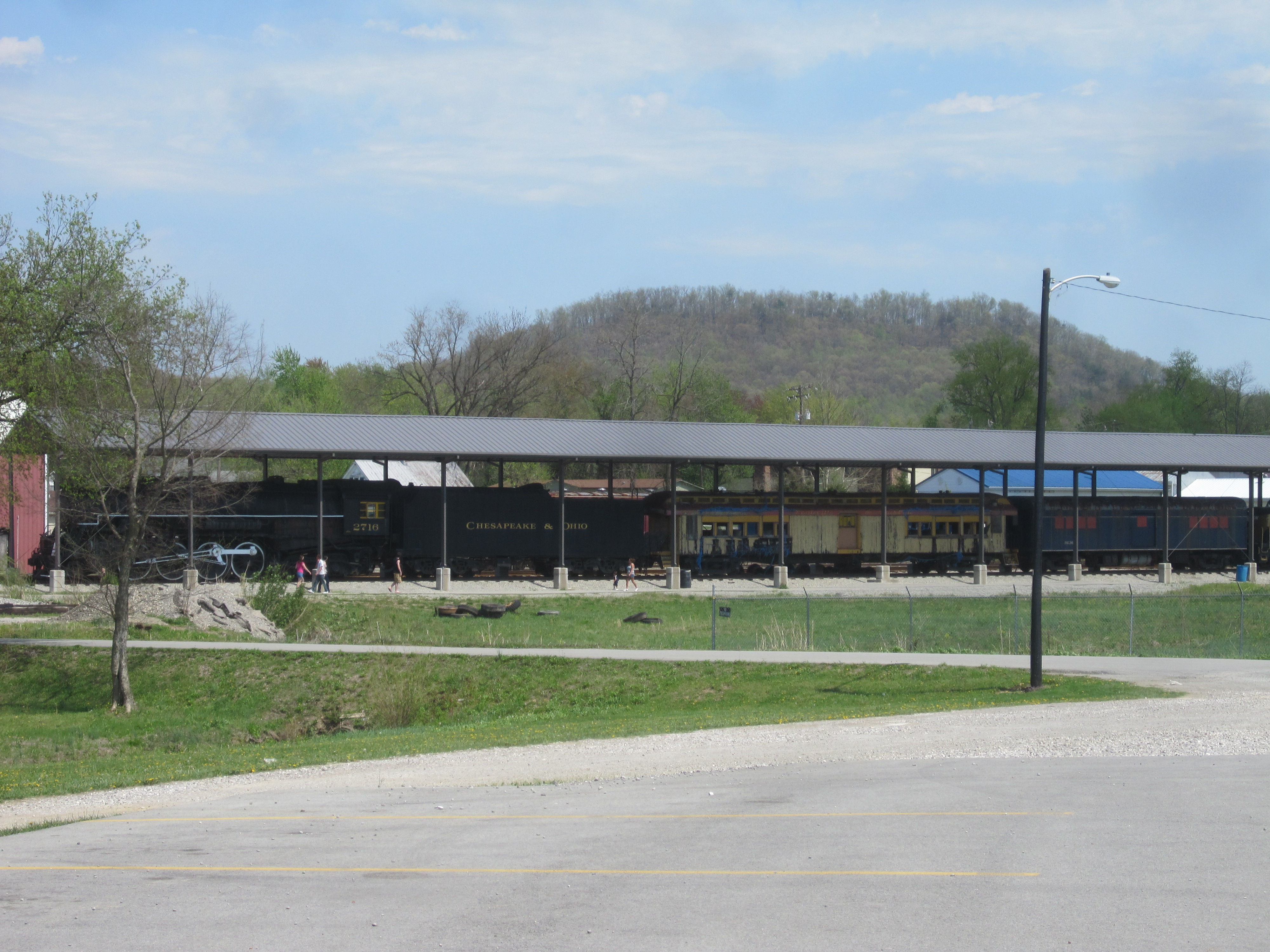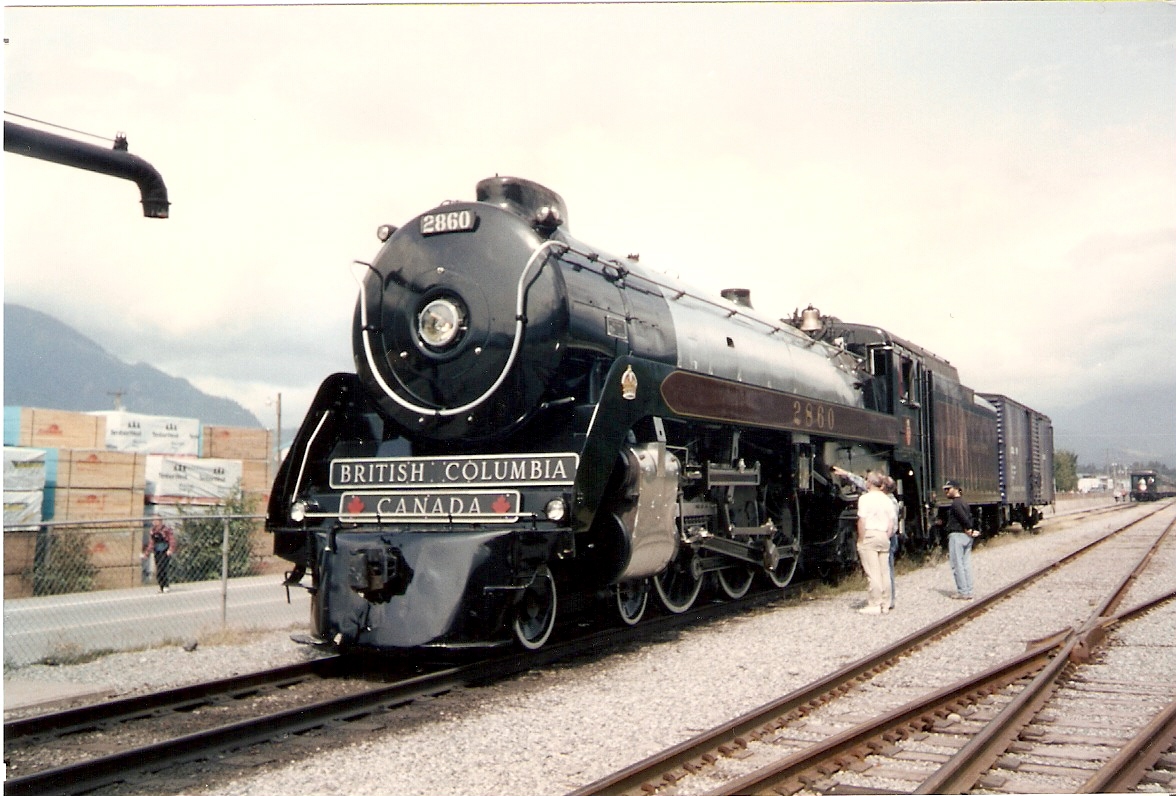|
Southern Railway 722
Southern Railway 722 is a class "Ks-1" 2-8-0 " Consolidation" type steam locomotive built in September 1904 by the Baldwin Locomotive Works for the Southern Railway (SOU).. History Revenue service The No. 722 locomotive was assigned to work on the Southern Railway's Murphy Branch, where it was primarily used to haul freight trains between Asheville and Murphy, North Carolina.. In August 1952, No. 722 was retired from revenue service after it pulled the last steam-powered freight train on the Murphy Branch. Three months later, No. 722 and sister locomotive No. 630 were both purchased by the East Tennessee and Western North Carolina Railroad (ET&WNC) and renumbered to Nos. 208 and 207, respectively... After ET&WNC's acquirement, Southern cut down the size of the two Ks-1 locomotives' tender coal bunker to give the engineer a clear view during numerous switching moves and reverse operation. Excursion service On December 8, 1967, No. 208 (No. 722) and No. 207 (No. 630) were both trad ... [...More Info...] [...Related Items...] OR: [Wikipedia] [Google] [Baidu] |
Savannah And Atlanta 750
Savannah and Atlanta 750, formerly Florida East Coast 80, is a 4-6-2 “ Light Pacific” steam locomotive built in January 1910 by the American Locomotive Company (ALCO) of Schenectady, New York, originally for the Florida East Coast Railway (FEC) as No. 80. Throughout the 1930s, FEC had sold of several of their locomotives, with No. 80 being sold in 1935 to the Savannah and Atlanta Railway, where it was renumbered to 750. The locomotive pulled commuter passenger trains and occasional mixed freight trains for the S&A, until the railroad dieselized in the early 1950s. In 1962, the locomotive was donated to the Atlanta Chapter of the National Railway Historical Society, who began using the locomotive to pull occasional excursion trains. No. 750 was subsequently leased to the Southern Railway for use to pull trains for their new steam excursion program, and the lease ended in 1984. From 1985 to 1989, the locomotive pulled excursion trains for the New Georgia Railroad around Atlanta, ... [...More Info...] [...Related Items...] OR: [Wikipedia] [Google] [Baidu] |
ALCO RS-3
The ALCO RS-3 is a , B-B diesel-electric locomotive manufactured from May 1950 to August 1956 by American Locomotive Company (ALCO) and its subsidiary Montreal Locomotive Works (MLW). A total of 1,418 were produced: 1,265 for American railroads, 98 for Canadian railroads, 48 for Brazilian railroads, and seven for Mexican railroads. The successor to the RS-1 and RS-2, the RS-3 was built with a single 12-cylinder ALCO Model 244 engine. The RS-3 greatly resembled the design and appearance of its predecessor, but had 100 more hp (1,600 hp) and some changes to the fuel system and body shape. Some had their engines replaced with more reliable EMD 567B engines, becoming RS-3ms. Much like the RS-1, many RS-3s served for decades; some are still in use as of 2022. Variants RSC-3: an RS-3 that used 3-axle trucks instead of 2-axle trucks. The middle axle on each truck was unpowered. This variant was designed for service on light track, as the extra axles better spread the weight of t ... [...More Info...] [...Related Items...] OR: [Wikipedia] [Google] [Baidu] |
Biltmore Village
Biltmore Village, formerly Best, is a small village that is now entirely in the city limits of Asheville, North Carolina and near the town of Biltmore Forest. It is adjacent to the main entrance of the Biltmore Estate, built by George W. Vanderbilt, one of the heirs to the Vanderbilt family fortune. Once known as the town of Best, George Vanderbilt created this village as a "company town" for the estate workers. The community was planned and designed to reflect the qualities of an English country village. The village had its own church, which is still in operation today as the Cathedral of All Souls, an Episcopal cathedral. The village also had a hospital, shops, a school, a train station A train station, railway station, railroad station or depot is a railway facility where trains stop to load or unload passengers, freight or both. It generally consists of at least one platform, one track and a station building providing ..., and other services available. Biltmor ... [...More Info...] [...Related Items...] OR: [Wikipedia] [Google] [Baidu] |
Norfolk Southern Railway
The Norfolk Southern Railway is a Class I freight railroad in the United States formed in 1982 with the merger of Norfolk and Western Railway and Southern Railway. With headquarters in Atlanta, the company operates 19,420 route miles (31,250 km) in 22 eastern states, the District of Columbia, and has rights in Canada over the Albany to Montréal route of the Canadian Pacific Railway. NS is responsible for maintaining , with the remainder being operated under trackage rights from other parties responsible for maintenance. Intermodal containers and trailers are the most common commodity type carried by NS, which have grown as coal business has declined throughout the 21st century; coal was formerly the largest source of traffic. The railway offers the largest intermodal rail network in eastern North America. NS was also the pioneer of Roadrailer service. Norfolk Southern and its chief competitor, CSX Transportation, have a duopoly on the transcontinental freight rail li ... [...More Info...] [...Related Items...] OR: [Wikipedia] [Google] [Baidu] |
Glossary Of Boiler Terms
Boilers for generating steam or hot water have been designed in countless shapes, sizes and configurations. An extensive terminology has evolved to describe their common features. This glossary provides definitions for these terms. Terms which relate solely to boilers used for space heating or generating hot water are identified by (HVAC). A-B ; : A container beneath the furnace, catching ash and clinker that falls through the firebars. This may be made of brickwork for a stationary boiler, or steel sheet for a locomotive. Ashpans are often the location of the damper. They may also be shaped into hoppers, for easy cleaning during disposal. ; Blastpipe: Part of the exhaust system that discharges exhaust steam from the cylinders into the smokebox beneath the chimney in order to increase the draught through the fire. ; Blow-down: Periodic venting of water from the boiler. This water contains the most concentrated precursors for sludge build-up, so by venting it whilst still ... [...More Info...] [...Related Items...] OR: [Wikipedia] [Google] [Baidu] |
Chesapeake And Ohio 2716
The Chesapeake and Ohio Railway No. 2716 is a class "K-4" 2-8-4 "Kanawha" (Berkshire) type steam locomotive built in 1943 by the American Locomotive Company (ALCO) for the Chesapeake and Ohio Railway (C&O). While most railroads referred to these 2-8-4 type locomotives as ''Berkshires'', the C&O referred to them as ''Kanawhas'' after the Kanawha River which flows through West Virginia. Used as a dual service locomotive, No. 2716 and its classmates served the C&O in a variety of duties until being retired from revenue service in 1956. Donated to the Kentucky Railway Museum of New Haven, Kentucky in 1959, No. 2716 has been restored to operation in excursion service twice since its retirement from the C&O, first in 1981 for the Southern Railway's steam program until 1982, and again in 1996 for a few brief excursions for the Fort Wayne Railroad Historical Society (FWRHS) in New Haven, Indiana. The locomotive is undergoing an extensive rebuild to operating condition for a third excursio ... [...More Info...] [...Related Items...] OR: [Wikipedia] [Google] [Baidu] |
Texas And Pacific 610
Texas and Pacific 610 is a class "I-1a" 2-10-4 "Texas" type steam locomotive that was originally operated by the Texas and Pacific Railway (T&P). It served the T&P from 1927 to 1951 before being donated to the city of Fort Worth. It was briefly used for the American Freedom Train in the mid-1970s, and subsequently for the Southern Railway steam program. Since 1982, No. 610 has remained on static display at the Texas State Railroad's ''Hall of Giants'' in Palestine. History Built in June 1927 by the Lima Locomotive Works, No. 610 and its class, the I-1s, were the first authentic 2-10-4s ever constructed. No. 610 was a major work-horse for the Texas and Pacific. By the early 1950s, the T&P had scrapped all of their "Texas" type locomotives, except Nos. 610 and 638, with No. 610 being donated to the Fort Worth Fat Stock Show in 1951 and the locomotive sat on display at the Will Rogers Memorial Center. Sister engine No. 638 also survived for a brief time as a display piece in th ... [...More Info...] [...Related Items...] OR: [Wikipedia] [Google] [Baidu] |
Royal Hudson
The Royal Hudsons are a series of semi-streamlined 4-6-4 "Hudson" type steam locomotives owned by the Canadian Pacific Railway (CPR) and built by Montreal Locomotive Works (MLW). The engines were built in 1937. In 1939, King George VI allowed the CPR to use the term after Royal Hudson number 2850 transported the royal train across Canada with no need of replacement. These locomotives were in service between 1937 and 1960. Four of them have been preserved. No. 2839 was used to power excursions for the Southern Railway Steam Program between 1979 and 1980. No. 2860 was used for excursion service in British Columbia between 1974 and 1999, then again between 2006 and 2010. Royal visit In 1939, King George VI and Queen Elizabeth visited Canada, arriving at Wolfe's Cove, Quebec, on 17 May 1939. This was the first time that a reigning monarch had visited Canada. The King and Queen took a tour of the country by rail. The CPR and the Canadian National Railways (CNR) shared the honours of t ... [...More Info...] [...Related Items...] OR: [Wikipedia] [Google] [Baidu] |
Superpower Steam
"Superpower steam" was a term coined by Lima Locomotive Works in the mid-1920s, referring to steam locomotives with booster-equipped four-wheel trailing trucks supporting large fireboxes, as well as enlarged superheaters. The wheel arrangements introduced in the 1920s for these locomotives were the 4-6-4's, 2-8-4's, 4-8-4's and 2-10-4's; and in the 1930s, the 2-6-6-4's. The term "superpower" was later often applied to all locomotives with 4-wheel trailing truck arrangements, though many did not have boosters and almost all steam of any wheel arrangement built after that time had large superheaters. The design was invented by Lima for the New York Central's Boston and Albany Railroad. The design was invented by Lima's Vice President of Engineering, William Woodard, who had experimented with a New York Central 2-8-2 Mikado in 1922. The new design called for double the firebox size than the earlier Mikados, thus giving it more grate area leading to the development of the 2-8-4. The l ... [...More Info...] [...Related Items...] OR: [Wikipedia] [Google] [Baidu] |
Chattanooga, Tennessee
Chattanooga ( ) is a city in and the county seat of Hamilton County, Tennessee, United States. Located along the Tennessee River bordering Georgia, it also extends into Marion County on its western end. With a population of 181,099 in 2020, it is Tennessee's fourth-largest city and one of the two principal cities of East Tennessee, along with Knoxville. It anchors the Chattanooga metropolitan area, Tennessee's fourth-largest metropolitan statistical area, as well as a larger three-state area that includes Southeast Tennessee, Northwest Georgia, and Northeast Alabama. Chattanooga was a crucial city during the American Civil War, due to the multiple railroads that converge there. After the war, the railroads allowed for the city to grow into one of the Southeastern United States' largest heavy industrial hubs. Today, major industry that drives the economy includes automotive, advanced manufacturing, food and beverage production, healthcare, insurance, tourism, and back office ... [...More Info...] [...Related Items...] OR: [Wikipedia] [Google] [Baidu] |
Wilmington And Western Railroad
The Wilmington and Western Railroad is a freight and heritage railroad in northern Delaware, operating over a former Baltimore and Ohio Railroad (B&O) branch line between Wilmington and Hockessin. The railroad operates both steam and diesel locomotives. It was added to the National Register of Historic Places as a national historic district in 1980. Wilmington & Western serves one customer for revenue service, and interchanges with CSX Transportation at Landenberg Junction, Delaware Wilmington & Western's two General Motors Diesel-Electric SW1 locomotives are the oldest in routine scheduled service. History The Delaware and Chester County Railroad was incorporated in February 1867 to build from Wilmington in the direction of Parkesburg or Atglen, Pennsylvania, and was renamed the Wilmington and Western Railroad in March 1869,Interstate Commerce Commission, 42 Val. Rep. 1 (1933): Valuation Docket No. 1068, The Baltimore and Ohio Rail Road Company and its Leased Lines opening ... [...More Info...] [...Related Items...] OR: [Wikipedia] [Google] [Baidu] |
Charleston, South Carolina
Charleston is the largest city in the U.S. state of South Carolina, the county seat of Charleston County, and the principal city in the Charleston–North Charleston metropolitan area. The city lies just south of the geographical midpoint of South Carolina's coastline on Charleston Harbor, an inlet of the Atlantic Ocean formed by the confluence of the Ashley, Cooper, and Wando rivers. Charleston had a population of 150,277 at the 2020 census. The 2020 population of the Charleston metropolitan area, comprising Berkeley, Charleston, and Dorchester counties, was 799,636 residents, the third-largest in the state and the 74th-largest metropolitan statistical area in the United States. Charleston was founded in 1670 as Charles Town, honoring King CharlesII, at Albemarle Point on the west bank of the Ashley River (now Charles Towne Landing) but relocated in 1680 to its present site, which became the fifth-largest city in North America within ten years. It remained unincorpor ... [...More Info...] [...Related Items...] OR: [Wikipedia] [Google] [Baidu] |

.jpg)


.jpg)

